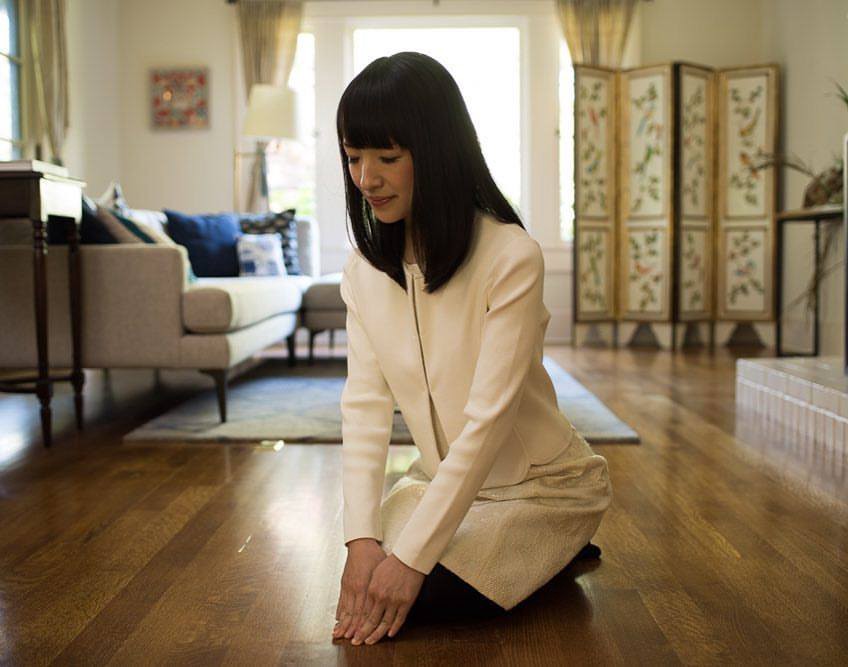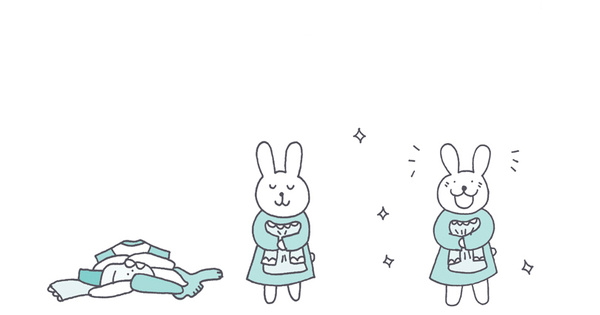Sparking Joy: Religion, Representation & Marie Kondo
A roundtable about what's really going on — and what's at stake — in Tidying Up
[The following has been edited for length, clarity, and the inclusion of citations].
Andrew Way Leong (AWL): Before we discuss Marie Kondo’s books, manga, and recent Netflix series, a caveat and some shout-outs.
First, Grace, Tara, and I are not religious studies scholars, but scholars trained in literary and cultural studies within the broader contexts of Asian American ethnic studies and Asian area studies. Accordingly, we are not interested in making definitive claims about what religion is, what Japanese religions are, and what is or isn’t an “authentic” Japanese religious practice. We are, instead, going to try to interpret how Marie Kondo’s print and visual media (specifically, her books, manga (comics), and Netflix show) depict practices and states of feeling that the media themselves describe as being derived from, or adjacent to, “religious,” “spiritual,” or “magical” practice and experience. We’ll also try to situate these descriptions within histories of popular media representations of people of Asian descent in North America and of domestic labor in Japan.
Second, thank you to all the commenters in the Facebook thread that informed our coming together for this discussion. Shout-outs go to Kerim Yasar, for pointing us to this Twitter thread by Jolyon Baraka Thomas (now expanded to an article) on hot takes of Kondo and “Shinto”; and to Jessie Starling, who, in another context, introduced me to the work of Jason Josephson-Storm. Storm’s books The Invention of Religion in Japan (Chicago, 2012) and The Myth of Disenchantment (Chicago, 2017) have both helped to shape our discussion about the Marie Kondo phenomenon.
Tara Fickle (TF): My first thought upon watching the Netflix show, Tidying Up with Marie Kondo, was how this series fits within a longer history of American media representations of Asians—1960s gurus, feng shui experts, and so on—who carry with them some kind of Asian spirituality that helps Westerners fix the problems of their materialist society.
 Grace En-Yi Ting (GET): I noticed similar issues when reading the Japanese manga adaptation (translated into English as The Life-Changing Manga of Tidying Up). In the original manga, Kondo is called a yōsei, a sort of spirit or sprite-type creature. When she goes into her back story, she’s depicted as a little bit weird–a tidying otaku or fanatic. She says that as an elementary school student, she just wanted to sort things and read lifestyle magazines for housewives. When she greets the house, or taps the books to wake them up, the manga’s main character, a twenty-nine year-old OL (“office lady”) seems surprised but tolerant, as if she’s thinking, okay, you do you, I get that you’re this otherworldly creature here to fix things in my ordinary life.
Grace En-Yi Ting (GET): I noticed similar issues when reading the Japanese manga adaptation (translated into English as The Life-Changing Manga of Tidying Up). In the original manga, Kondo is called a yōsei, a sort of spirit or sprite-type creature. When she goes into her back story, she’s depicted as a little bit weird–a tidying otaku or fanatic. She says that as an elementary school student, she just wanted to sort things and read lifestyle magazines for housewives. When she greets the house, or taps the books to wake them up, the manga’s main character, a twenty-nine year-old OL (“office lady”) seems surprised but tolerant, as if she’s thinking, okay, you do you, I get that you’re this otherworldly creature here to fix things in my ordinary life.
AWL: So there are two layers here. One is that the show might be feeding off a long pattern of Anglo-American representations of Japan as “a fairyland” where one finds “one’s way among quaint and mirthful Orientals.”[1] The other is that in a manga first produced for a Japanese audience, Marie Kondo’s persona also appears “otherworldly” as a yōsei, or just slightly “weird,” as a tidying otaku.
TF: This otherworldly quality carries over into the production design of the Netflix show, which often makes Kondo seem strangely separated from ordinary space and time. She’s always in a similar outfit—pure white tops and cardigans—so it’s very hard to tell how much time has passed by looking at her. Plus the constant cuts to her sitting in a separate, ethereal, magical space – the New York Times nicely describes this set as “some pristine, enchanted space where the camera visits Ms. Kondo.”
GET: Even when Kondo enters and exits her clients’ homes, it seems like she’s just slipping in and out, to the extent that by the end of an episode, I sometimes think, “so what did she really do?” even if I don’t expect her to do manual labor. And then she will go into people’s houses and say something like, “Oh, you’re having a baby!” As if she doesn’t know anything about them.
TF: Right, didn’t the producers let her know anything about who she was visiting?
GET: So there’s the pretense of surprise, some type of distance that she wants to hold, or that is being held for her. Part of this has to do with the way she’s speaking. When she’s not saying a few phrases in English, she’s speaking only in formal, business Japanese. It’s a bit feminine and extremely polite – it’s Japanese that you’re trained to use. She creates a sense of formal distance where it’s clear that the client’s home is her workplace.
TF: I remember thinking how strategic the choice of the translator was. Because it’s clear that Kondo speaks a good amount of English, and at different times she chooses to be the main speaker, but at others she chooses to very intentionally back off and create a similar kind of distance by having everything go through the translator.
AWL: This discussion of the clients’ home as workplace also makes me think about Kondo’s description of her “custom” of kneeling on the floor to perform a silent greeting to her clients’ home. In the English edition of The Life-Changing Magic of Tidying Up, Kondo writes, “I began this custom quite naturally based upon the etiquette of worshipping at Shinto shrines. . . . because the tense expectancy in the air when a client opens the door resembles the atmosphere when one passes under the shrine gate and enters the sacred precincts.” Is a client’s home really analogous to a sacred space?
To unpack what’s going on here, I think we can turn to the work of Talal Asad and Sylvia Federici. Asad argued that Western European notions of “secular society” depend upon a public/private distinction where religion and the sacred are relegated “to the private domain” such that religious feelings become part of a “range of personal sensibilities.”[2] Federici points to a similar turn in medieval Europe where the domain of social reproduction, or “the reproduction of workers” shifted from the “public space” of “the common, the church,” to the private space of the “home.”[3]
Kondo’s show seems to reinforce European senses of the idea of the private home as analogous to a sacred domain for private religious practice, but the show also crosses the public/private threshold by displaying the clients’ home as a televised workplace. Kondo’s simultaneous reinforcement and crossing of this public-secular versus private-religious threshold is important to note when we think about how, in Euro-American contexts, this threshold has aligned with ideas about binary gender roles — in other words, the notion that men are supposed to work in the public realm for hourly wages while the timeless, sacred duty of women is to maintain the private home.

Marie Kondo
GET: It’s hard for me to view this as “timeless” because I see what Kondo’s doing as an extension of pressures placed on Japanese women with contemporary shufu, or housewife, discourses. Ofra Goldstein-Gidoni describes this as the “new happy housewife” phenomenon of contemporary Japan.[4] Where housewives used to be pressured to just labor, now housework must involve the joy of self-fulfillment too. Kondo’s 2011 idea of “sparking joy” also resembles other contemporary Japanese political discourses of how women ought to “twinkle” or “shine.” Here I am reminded of Prime Minister Shinzō Abe’s 2013 speech to the UN in which he declared his intention to help working women in order to “create a society ‘in which women shine.’”
AWL: Now that you mention it, there is an odd grammatical parallelism between Abe’s subete no josei ga kagayaku shakai zukuri honbu [Office for Creating a Society Where Every Woman Shines) and Kondo’s jinsei ga tokimeku katazuke no mahō [Magic of Life-Changing (or Joy Sparking) Tidying Up]. Both are in the form noun, intransitive verb, verbal noun, noun.
GET: I think some of these specific, gendered dimensions of Marie Kondo’s persona and products get wiped away in translation.
TF: Maybe Kondo’s method of tidying appeals to American audiences exactly because the criteria of “sparking joy” seems to set aside more typical economic criteria like exchange value or function. Questions like, “do you still use it?” fall away. When she talks about a client who got rid of fifteen garbage bags worth of stuff, the question, “ how much money did all of that cost?” disappears.
GET: In the manga, she says there are three ways of valuing objects. One is about the actual function of the object…
TF: Literal use-value!
GET: Another is information (i.e. books), and the third is feeling or emotion, which goes along with “tokimeki,” the sparking joy aspect. And that’s the one she cares about.
AWL: What do you make of this translation of “tokimeki” as “sparking joy”?
GET: “Tokimeki” shows up all the time in shōjo manga (girls’ comics). It’s this feeling of romantic anticipation, where your heart beats faster. It isn’t exactly the same as “doki doki,” which is an onomatopoeia for the sound that your heart is making, but a related word.
AWL: “Spark joy” also has unexpected resonances in English. “Joy” is an odd phrase to use in everyday life – people don’t walk around saying, “How are you?” “I’m joyous.” For me the word brings to mind heightened, maybe even “religious” states of feeling – as in “Joy to the World” and “Ode to Joy.”
I have no idea if this is where translator Cathy Hirano got the “spark joy” idea, but one of the key lines in Friedrich Schiller’s poem “Ode to Joy” is “Freude, schöner Götterfunken” (“Joy, beautiful spark of the gods”). Schiller is only one among many European artists and thinkers who have been attached to ideas of “the divine spark” or forms of “enchanted nature” where spirits or fragments of the divine are understood to vitalize all of creation. All this is to say that holding the belief that objects can possess, give, or spark life, is first, not in any way restricted to Japan, and second, not universal to all Japanese people.
TF: Both the Netflix show and Kondo’s second book (Spark Joy: An Illustrated Master Class on the Art of Organizing and Tidying Up) contain illustrations of what sparking joy looks like. In the show, Kondo clutches an object to herself and makes this face that’s like, “Ding”! In the illustrated book, there’s a cartoon rabbit that does the same thing. Both of these seem light and cute, but they’re also didactic. What Kondo is trying to do is to teach you to make aesthetic judgements, not so much honing your appreciation for beauty, but honing your capacity to identify how objects make you feel.

AWL: So here Asad’s point about the European secular/religious split depending upon a celebration of personal feelings illustrates one of the limitations of Kondo’s accounts of aesthetic judgement via sparking joy. I can’t help but think that there’s a better, more collective account of the “aesthetic” to be found through a phrase that’s been problematically appropriated from the Black queer and trans ballroom community: “X gives me life.”
In a blogpost on the phrase, Azizi Powell quotes an observation that older uses of the phrase were restricted to “mother” and “God,” but now extend to anything or anyone that “gives an individual or group of people energy (vitality), validity, or significance.”
To be clear, I don’t want to see season two of the Netflix show featuring white suburbanites replacing the question “does this spark joy” with “does this give me life.” However, I do think the phrase “gives me life” better recognizes how members of marginalized communities who have been rejected by birth families (as signified by “mother”) and cast out from the church (“God”) have nevertheless found and been given life through aesthetic practices of collective art and performance.
TF: I’m curious about how Kondo’s method is presented as universally applicable. The Netflix show relentlessly displays diversity in the sense that every single episode has to be different — “the gay couple,” “the Japanese American couple,” “the widow” — and yet, all of them are universally served by her method. In the book she even says, “I thought about tailoring my method to each individual, but then I realized everyone is pretty much the same and can all benefit from my method.”
AWL: I just read Annie McClanahan’s Post-45 piece on contemporary TV and “tipworkification” and so have “types” on my mind. It’s embarrassing, but I can’t remember the names of any of the clients. I think this is because of how important type-work is for the genre of home improvement shows.
TF: Tidying Up seems like the pinnacle of “people are their houses” metaphors. There seemed to be no irony in the episode in which the gay couple – it’s true, the show is typological, I can’t remember their names – talked about how much stuff was in their closets.
GET: Marie Kondo herself might even be understood as a portable type — a way of packaging a “Japanese art” from “Japanese culture” in a easily digestible form. The engagement between a Japanese woman and these diverse couples is presumed to be something that is not difficult or tense, as if Kondo were representing a nation that does not have its own significant problems with racism, sexism, and homophobia.
All:
This is an untidy ending to a discussion that could go on for much longer, but it’s at least a start for working through the mess of thoughts and feelings that surrounds the “Marie Kondo phenomenon.”
***
[1] Douglas Sladen, Queer Things about Japan (London: Anthony Treherne, 1904) 110.
[2]Talal Asad, Thinking about Secularism and Law in Egypt, ISIM Paper, 1 – 24 (2001). ISIM, Leiden, 1. .
[3] Sylvia Federici, Caliban and the Witch: Women, the Body, and Primitive Accumulation (Brooklyn, NY: Autonomedia, 2014), 84.
[4] Ofra Goldstein-Gidoni, Housewives of Japan: An Ethnography of Real Lives and Consumerized Domesticity (New York, NY: Palgrave Macmillan, 2012), 147.
***
Tara Fickle is an assistant professor of English and affiliated faculty in the Department of Ethnic Studies, Center for Asian Pacific Studies, New Media & Culture Certificate, and Digital Humanities Minor at the University of Oregon.
Andrew Way Leong is an assistant professor of English and core faculty in the Center for Japanese Studies at the University of California, Berkeley.
Grace En-Yi Ting is a postdoctoral fellow specializing in contemporary Japanese literature and girls’ culture in the Faculty of Letters, Arts & Sciences at Waseda University.
***
Published with support from the Henry R. Luce Initiative on Religion in International Affairs.
